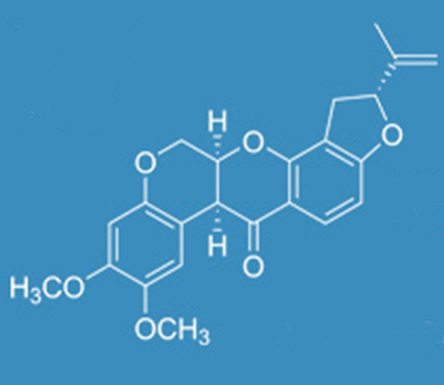Environmental Fate Studies
This section contains information on the behavior of rotenone in the environment, particularly in water and sediment.
Campbell, C., and D. Rueppel. 2006. Lawrence Livermore National Laboratory Rotenone Project Data Summary UCRL-AR-226299. Lawrence Livermore National Laboratory, Livermore, CA. To read the entire report: Campbell and Rueppel (2006) UCRL-AR-226299_Final
Cheng, H., I. Yammamoto, and J. Casida. 1972. Rotenone photodecomposition. Journal of Agricultural Food and Chemistry 20:850-856. To read the entire article: Cheng et al. 1972 (Rotenone Photodecomposition)
Dawson, V. 1986. Adsorption-desorption of [6a-14C] by bottom sediments. USFWS, National Fishery Research Laboratory, La Crosse, WI. To read the entire report: Dawson 1986 (Report); Dawson 1986 (Figures 1-24); Dawson 1986 (Tables 1-22)
Draper, W. 2002. Near UV quantum yields for rotenone and piperonyl butoxide. Analyst 127: 1370-1374. To read the entire article: Draper 2002 (Royal Society Chemistry 127_1370-1374)
Eilers, J., D. Loomis, A. St. Amand, L. Jackson, J. Kaan, B. Eilers, H. Truemper, J. Cornett, and R. Sweets. 2007. Biological effects of repeated fish introductions in a formerly fishless lake: Diamond Lake, Oregon, USA. Fundamental and Applied Limnology 169(4) 265-277. To read the entire article: Eilers et al. 2007
Eilers, J., H. Trueper, L. Jackson, B. Eilers, and D. Loomis. 2011. Eradication of an invasive cyprind (Gila bicolor) to achieve water quality goals in Diamond Lake, Oregon, (USA). Lake and Reservoir Management 27:194-204. to read the entire article: Eilers et al 2011
Fang, N., and J. Casida. 1999. Cube resin insecticide: identification and biological activity of 29 rotenoid constituents. Journal of Agricultural Chemistry 47(5):2130-2136. To read the entire article: Fang and Casida 1999
Fang, N., and J. Casida. 1998. Anticancer action of cube´ insecticide: Correlation for rotenoid constituents between inhibition of NADH:ubiquinone oxidoreductase and induced ornithine decarboxylase activities. Proceeding National Academy of Sciences:95: 3380–3384. To read the entire article: Fang and Casida 1998
Fang, N., and J. Casida. 1997. Novel bioactive cube insecticide constituents: isolation and preparation of 13-hom0-13-oxa-6a,12a-dehydrotenoids. Journal of Organic Chemistry 62:350-353. To read the entire article: Fang and Casisa 1997
Fang, N., J. Rowlands, and J. Casida. 1997. Anomalous structure-activity relationships of 13-homo-oxatorenoids and 13-homo-oxadehydrorotenoids. Chemical Research and Toxicology 10(8):853-858. To read the entire article: Fang et al. 1997
Finlayson, B., J. Trumbo, and S. Siepmann. 2001. Chemical residues in surface and ground waters following rotenone application to California lakes and streams. Pages 37-53 in R. Cailteux, L. DeMong, F. Finlayson, W. Horton, W. McClay, R. Schnick, and C. Thompson, editors. Rotenone in fisheries: are rewards worth the risks? American Fisheries Society, Trends in Fisheries Science and Management I, Bethesda, MD. To read the entire article: Finlayson et al. 2001
Finlayson, B., Eilers, J. and H. Huchko. 2014. Fate and behavior of rotenone in Diamond Lake, Oregon, USA, following invasive tui chub eradication. Environmental Toxicology and Chemistry 33(6):1630-1655. To read the entire article: Finlayson et al. 2014
Gilderhus, P.A. 1982. Effects of an aquatic plant and suspended clay on the activity of fish toxicants. North American Journal of Fisheries Management 2:301-306. To read the entire article: Gilderhus (1982)
Gilderhus, P.A., V.K. Dawson and J.L Allen. 1988. Deposition and persistence of rotenone in shallow ponds during cold and warm seasons. Investigations in Fish Control 95. USFWS, Washington, D.C. To read the entire article: Gilderhus et al. 1988
Gingerich, W., and J. Rach. 1985. Uptake, biotransformation and elimination of rotenone by bluegills (Lepomis macrochirus). Aquatic Toxicology 6:179-196.
McMillin, S. and B.J. Finlayson. 2008. Chemical residues in water and sediment following rotenone application to Lake Davis, California 2007. California Department of Fish and Game, OSPR Administrative Report 08-01, Rancho Cordova. To read the entire report: McMillin and Finlayson 2008
Redman, C., J. Wesolowski and L Tomco. 2021. Photochemical pathways of rotenone and deguelin degradation: implications for rotenoid attenuation and persistence in high-latitude lakes. Environmental Science and Technology 55: 4974-4983. Redman et al. 2021 redman-et-al-2021-photochemical-pathways
Slabbert, E., M. Jordaan, and O. Weyl. 2014. Analysis of active rotenone concentration during treatment of the Rondegat River, Cape Floristic Region, South Africa. African Journal Aquatic Sciences 39:467-472. To read the entire report: Slabbert et al 2014
Spare, w. 1982. Aqueous photodegradation of 14C-rotenone. Final Report November 1982 submitted to USFWS National Fisheries Research Laboratory by Biospherics Incorporated, Rockville, Maryland. To read the entire report: Spare 1982
Thomas, R. 1983. Hydrolysis of [6-14C]-rotenone. Final Report June 30, 1983 submitted to USFWS National Fishery Research Laboratory, by Borriston Laboratories, Inc., Temple Hills, MD. To read the entire report: Thomas 1983 (Borriston Project 0301A)
Vasquez M., Rinderneck, J., Newman, J., McMillin, S., Finlayson, B., Mekebri, A., Crane, D., and R. Tjeerdema. 2012. Rotenone formulation fate in Lake Davis following the 2007 treatment. Environmental Toxicology and Chemistry 31(5): 1032-1041. To read the entire article: Vasquez et al. 2012
Westervelt, J. 2007. Lake Davis pike eradication project personal air monitoring report. California Department of Fish and Game, Office of Spill Prevention and Response, Sacramento. To read the entire report: Air Monitoring Report – Lk Dvs

